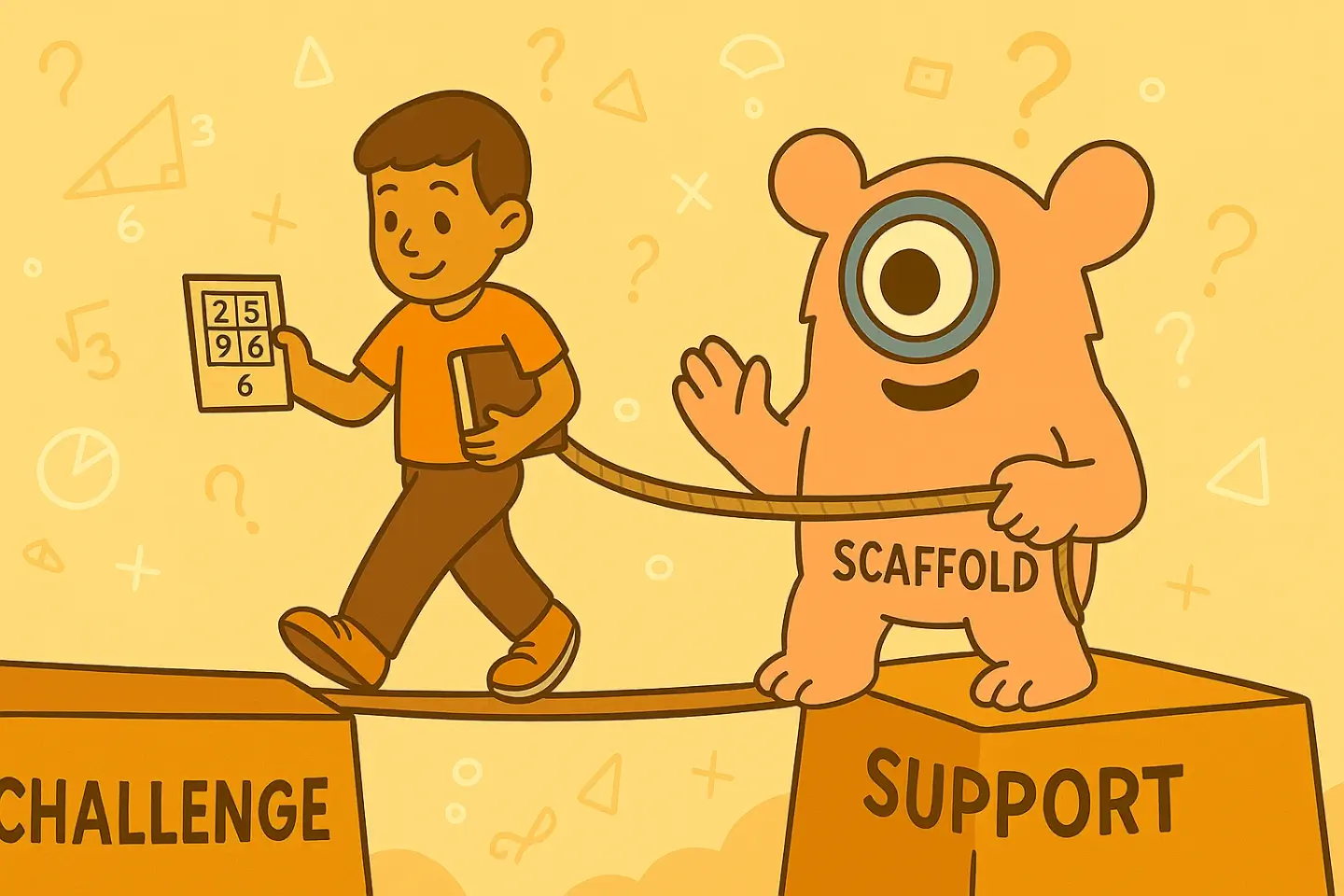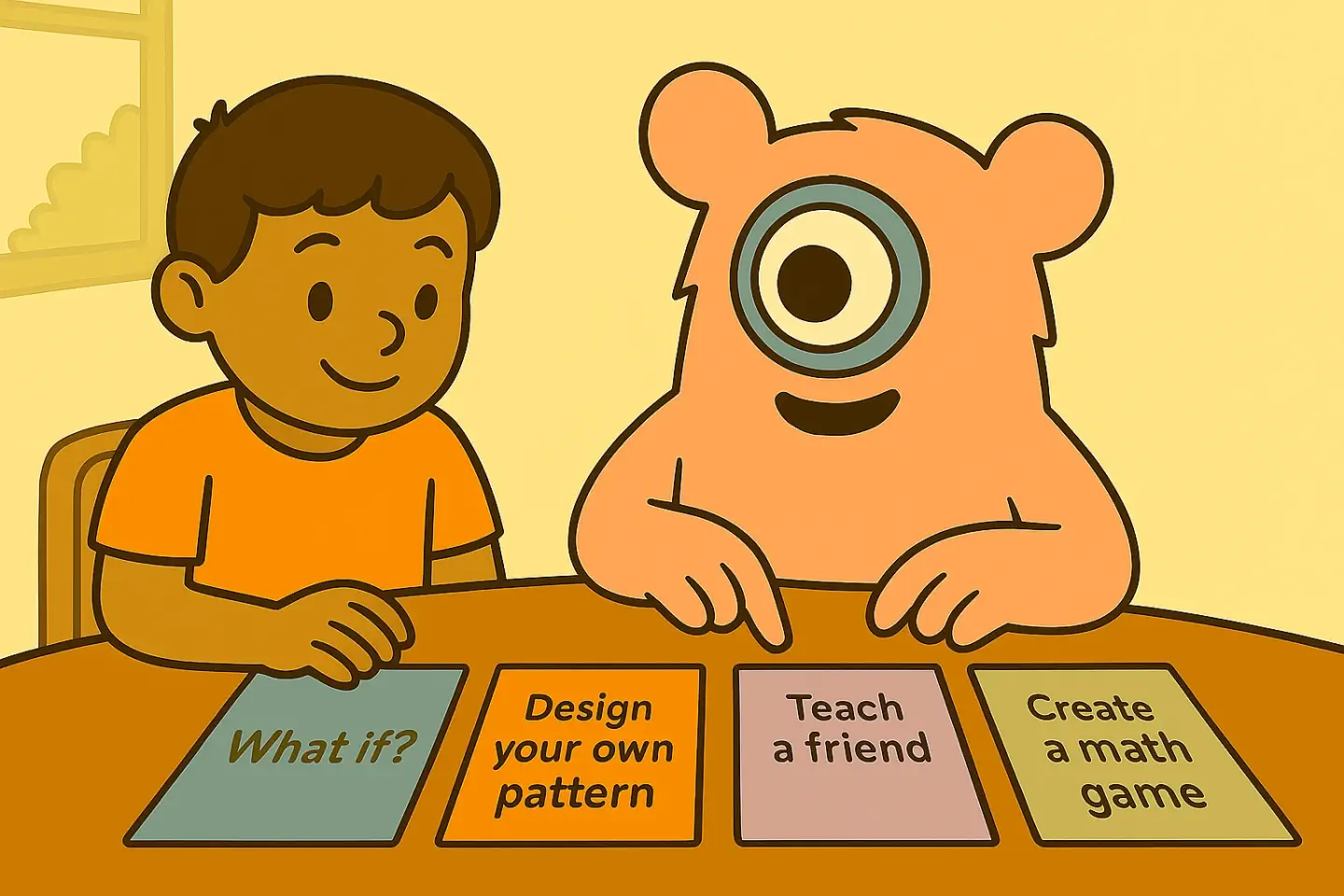Enrichment Without Overload: Challenging 2e Students in Math Class
TL;DR:For 2e math learners - that is, those gifted AND with a learning difference - enrichment works best when it is aligned with their strengths - open-ended and supported, paced flexibly, and built into the routine rather than tacked on. Monitor for overload, scaffold organization/executive demands, and allow choice of task and product. The result: meaningful mathematical challenge, maintained motivation and growth - without burnout.
As a teacher or parent working with a twice-exceptional (2e) learner in math, you know that the path can feel like walking a high wire. On one side: the student’s gifted potential. On the other: their learning or processing challenges. How do you provide meaningful enrichment that stretches them - without swamping them? In this article we’ll walk through a practical, friendly roadmap for delivering math enrichment for 2e students (“gifted + learning difference”) that honours their strengths and supports their hurdles.
What does “2e” mean - and why it matters in math
The term twice-exceptional (or “2e”) refers to learners who are gifted in one or more areas AND who also have a learning difference such as ADHD, autism spectrum disorder, dyscalculia, or other processing/organization difficulties. A recent review described 2e as students “who demonstrate the potential for high achievement … and who manifest one or more disabilities”.
In mathematics classrooms this combination can look like: a student who is eager for challenging problem solving, but who freezes up when the teacher says “show your work” or “explain your thinking.” Or a child who thinks like someone two grades ahead in abstraction, yet struggles with the layout, organization or stamina to complete a multi-step task. In fact, one large U.S. dataset found that about 17% more students with IEPs should have been identified in gifted mathematics programs - and thus many 2e learners remain under-recognised.
For teachers and parents, that means we must intentionally design math experiences that both challenge and support- not just more of the same or “easier” tasks. The goal: enrichment without overload.
The challenge of math enrichment for 2e students
Why is this tricky? A few reasons:
- Enrichment often means “faster pace, more complexity, more abstraction.” But for a 2e learner, the extra cognitive load of meta-thinking, organization, transitions, or fine motor demands (writing) may undermine that benefit. Indeed, a study found that 2e students often excel in enriched, strength-oriented environments that accommodated their differences, yet suffer when the environment is too conventional.
- Teachers may struggle to recognize that a 2e student’s under-achievement in some areas (e.g., computation or attrition in class) co-exists with high potential, especially in math reasoning. For example, in England a study of primary teachers found that knowledge of 2e maths learners was limited.
- Enrichment too early or too intense may lead to frustration, avoidance, or disengagement - especially when the student’s executive functioning, stamina or organization lag behind their reasoning ability.

Key principles for effective enrichment without overload
Here are five guiding principles to keep front-of-mind when designing enrichment for 2e math learners.
- Start from the student’s strength zone. Identify what the student can do easily (e.g., abstract reasoning, pattern spotting) and build from there. You’ll engage their gifted side rather than overwhelm their weaker side. For example: if they enjoy exploring number-theoretic patterns, you might offer an open-ended task about “what happens when you square two-digit numbers” rather than pushing more drills.
- Make the task open-ended and multi-entry. Enrichment-style tasks that allow different entry points, self-paced choice and extension space work well. Research on mathematically gifted students emphasises open, inquiry-based problem fields rather than tightly structured drill. This approach gives the 2e learner space to engage their gifted mind without being derailed by the rigid pace or procedural demands.
- Support executive/organization load explicitly. Offer scaffolds: checklists for multi-step work, graphic organisers to map out “what I know / what I’ll try / what I’ll check”, built-in reflection moments (“did I show my thinking?”). These reduce the hidden cognitive cost so the student can focus on the reasoning. In other words: enrichment is not just “harder” - it must be “supported”.
- Differentiate pace and product, not just content. Don’t just throw advanced content at the student - allow alternate ways to demonstrate understanding (verbal explanation, visual model, peer-teaching) and flexible timelines. Research shows that flexibility in product and pace is especially important for 2e learners.
- Embed habit-forming reflection and meta-thinking. Enrichment tasks often engage deeper thinking - but for 2e students this meta-thinking (e.g., “how did I approach this?”, “what did I assume?”, “what error area should I check?”) can itself be challenging. Build in mini-reflection prompts, peer discussion or teacher modelling of how to think about thinking in the task.
Concrete strategies for math enrichment with 2e learners
Here are some practical strategies you can implement in the classroom or at home.
1. “Challenge & Choice” menus
Create a menu of enrichment tasks layered by complexity. For example, in a unit on algebraic thinking:
- Tier A: Investigate “what happens if you change the coefficient sign in this expression?”
- Tier B: Design your own expression that yields only even outputs for integer inputs.
- Tier C: Write a short explanation for a peer about why odd × odd = odd, and create a mini-game around it.
A 2e learner can select Tier B or C while another one takes Tier A. Both are enriched but allow flexibility of entry and product.

2. Use “why note” and “what if” extensions
Encourage questions like “Why does this pattern occur?” and “What if I changed the rule slightly - what emerges?” The joy of mathematics often comes from such explorations rather than only speed or volume of problems.
3. Scaffold the “work shown” without turning into drill
A common pitfall: the 2e student says “I solved it in my head” and teacher asks “show your work”. Reaction: they blank. Solution: provide graphic “math-map” templates that guide them:
- Step 1: “I know …”
- Step 2: “I’ll try …”
- Step 3: “I found …”
- Step 4: “I’ll check …”
This keeps cognitive demands lower and allows the student’s reasoning to flourish without being blocked by organization overhead.
4. Enrichment clusters or mixed-ability peer-groupings
Whenever possible, group the 2e learner with peers who are curious and open to variation. Mixed-ability enrichment clusters give the 2e learner access to peer modelling, and reduce the isolation of “gifted but different”. They also allow pacing flexibility: the group may pause, reflect, skip ahead as needed.
5. Home-school partnership: invite strength-based enrichment
At home, invite the student to choose a mathematical “investigation” aligned with their interest: e.g., designing a board game around prime-numbers, or exploring Fibonacci patterns in art. Encourage them to document their process (photos/sketches) rather than just worksheet outputs. Then link back to class: perhaps they share their exploration, deepen it, or extend it. For 2e students, linking home interest-driven enrichment to class work helps sustain motivation and bridges gifted interest with formal instruction.
Balancing stretch and support: monitoring overload
How do you know you're overloading the 2e learner? Watch for signs like: frustration, avoidance, repeatedly skipping parts of tasks, sloppy work in areas they normally excel, drop in confidence, or refusal to start. To stay balanced:
- Keep enrichment sessions short and focused - e.g., 15-20 minutes rather than hour-long stretches.
- Alternate challenge days with “deepening” days (where the student revisits topics from class at their pace) to build consolidation.
- Embed check-ins: “How did this feel?” “Which part got tricky?” “What would make next time easier/more fun?”
- Ensure that underlying skills (computation, organization, writing out reasoning) are not ignored in favour of just the “fun part” of math. The 2e learner still needs foundational fluency to access the enrichment at full capacity.
Conclusion
When enrichment feels supportive rather than stressful, 2e students get to experience the best of both worlds - the thrill of challenge and the safety of understanding. By tuning into their strengths, offering flexibility, and keeping joy in the process, we can make math a place where every twice-exceptional learner feels both stretched and seen.
FAQs
Q: Isn’t enrichment just “more difficult work”?
Not really. For 2e students, true enrichment means deeper, broader, and supported work - not just more pages. It emphasises open-endedness, extension, choice and metacognition.
Q: How do I avoid giving too much and causing stress?
Monitor the student’s behaviour and feelings, keep tasks shorter, embed reflection, allow choice, and scaffold organisation. Keep the teacher/parent dialogue open: “How is this task for you?”
Q: What if my 2e learner resists enrichment tasks and just wants “normal” worksheets?
That’s a sign you might be missing their gifted side because of the weaker side getting in the way. Try offering a “two-track” plan: one track is steady state (solidify skills), the other is “interest branch” (open-ended enrichment). Give them choice and autonomy.
Q: How much enrichment is enough?
There’s no fixed number. A good rule: rather than hours, aim for integrated enrichment - a few minutes daily of challenge or investigation, woven into regular math routines, rather than “1 hour extra” once a week.
References
- Gierczyk, M. & Hornby, G. (2021). Twice-Exceptional Students: Review of Implications for Special and Inclusive Education. Education Sciences, 11(2), 85. https://files.eric.ed.gov/fulltext/EJ1288320.pdf
- Jolly, J. L., et al. (2024). Special Education Status and Underidentification of Twice‐Exceptional Students. Education Sciences, 14(10). https://www.mdpi.com/2227-7102/14/10/1048
- Willard-Holt, C., Weber, J., Morrison, K. L., & Horgan, J. (2013). Twice-exceptional learners’ perspectives on effective learning strategies. Gifted Child Quarterly, 57(4), 247-262.
https://dlogifted.wordpress.com/wp-content/uploads/2016/10/twice-exceptional-learners-perspectives-on-effective-learning-strategies.pdf - Dimitriadis, C. (2021). Twice-Exceptional Students of Mathematics in England: What Do the Teachers Know? British Educational Research Journal. https://discovery.ucl.ac.uk/id/eprint/10126148/1/Twice-exceptional%20students%20of%20mathematics_accepted%20version.pdf
- Shukla, A. B. (2022). On teaching mathematics to gifted students: Some enrichment ideas and educational activities. https://arxiv.org/pdf/1911.10726v2
